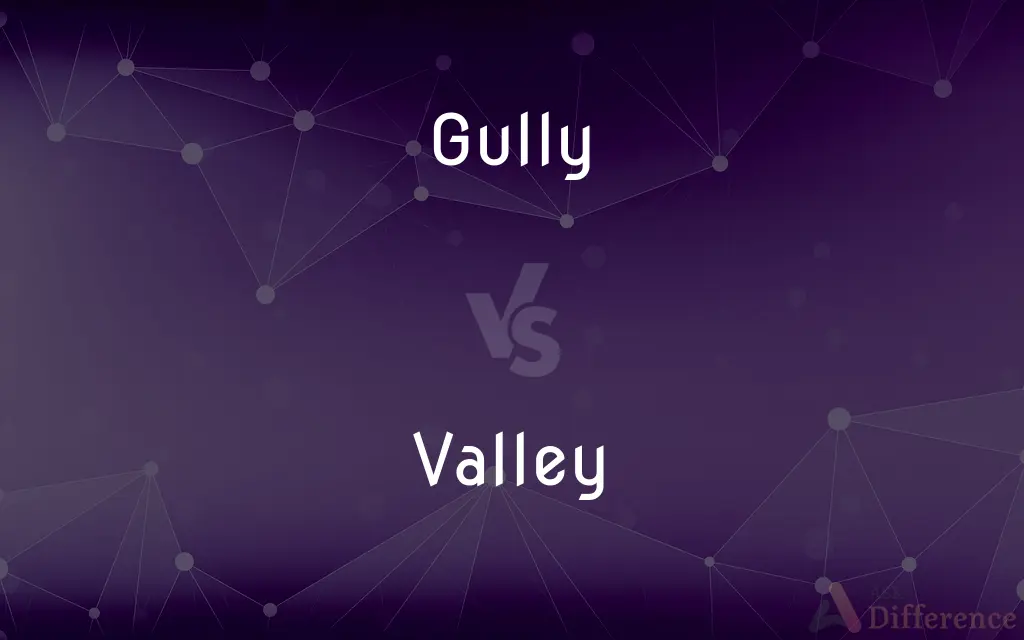Gully vs. Valley — What's the Difference?
By Urooj Arif & Fiza Rafique — Updated on March 28, 2024
A gully is a narrow and deep channel formed by water erosion, often found on hillsides or in areas with loose soil. A valley, however, is a wide, flat area between hills or mountains, typically formed by river, glacial activity over a much longer period.

Difference Between Gully and Valley
Table of Contents
ADVERTISEMENT
Key Differences
Gullies are formed by the rapid flow of water after heavy rains, cutting deep channels into the soil or sediment. These features are usually small in scale and can expand quickly, contributing to soil erosion and landscape changes. Valleys, in contrast, are large-scale geographical features that form over thousands or millions of years due to the steady erosion caused by rivers or the movement of glaciers, which carve out wide and often fertile lands between mountains or hills.
While gullies are often associated with negative impacts, such as soil degradation and loss of arable land, they are specific to areas with significant runoff and can become stabilized through vegetation growth or human intervention. Valleys, on the other hand, are vital components of river systems and often serve as corridors for wildlife, human settlement, and agriculture, thanks to their generally fertile soils and access to water.
The formation of a gully is typically a sign of environmental distress, indicating areas where the land is not adequately absorbing rainfall, often due to deforestation, overgrazing, or poor land management practices. Valleys, however, are natural components of the earth's topography and play essential roles in ecosystems, serving as drainage basins for rivers and streams and providing habitats for diverse flora and fauna.
Gullies may evolve into larger erosional features but usually remain significantly smaller than valleys. They are characterized by steep sides and can be a few meters to tens of meters in depth and length. Valleys have a much more extensive and varied range, from small river valleys to vast rift valleys, defined by their gentle slopes and wide, flat floors.
The primary distinction lies in their scale, formation process, and ecological impact. Gullies are more immediate and localized, often indicating recent or ongoing environmental issues, while valleys are grand, stable features of the landscape that support a wide range of biological diversity and human activities.
ADVERTISEMENT
Comparison Chart
Definition
A narrow and deep channel formed by water erosion.
A wide, flat area between hills or mountains, formed by river or glacial activity.
Formation Process
Rapid water flow, especially after heavy rains.
Long-term erosion by rivers or glaciers.
Scale
Small-scale, can form and expand quickly.
Large-scale, forms over thousands to millions of years.
Ecological Impact
Often indicates soil erosion and degradation.
Supports ecosystems, agriculture, and human settlements.
Characteristics
Steep sides, narrow and deep.
Wide and flat, with gentle slopes.
Examples
Erosional channels on hillsides or agricultural land.
The Grand Canyon, Yosemite Valley.
Compare with Definitions
Gully
A small, narrow channel formed in the earth by running water after a heavy rain.
The recent storm carved new gullies on the hillside.
Valley
Formed over a long period by river or glacial erosion.
The valley was carved out by a glacier thousands of years ago.
Gully
May become stabilized through natural processes or human intervention.
Planting grass along the gully can help prevent further erosion.
Valley
Can vary in size from small river valleys to large rift valleys.
The Great Rift Valley is one of the most prominent geographical features on Earth.
Gully
Often found in areas with loose soil or poor vegetation cover.
Gullies are common in areas where the land has been overgrazed.
Valley
Often serves as a natural corridor for wildlife and human migration.
The valley has been a migration path for animals and humans for centuries.
Gully
Characterized by steep sides; depth and width can vary.
Erosion control measures are necessary to prevent gully formation.
Valley
A broad area of land between mountains or hills, often with a river running through it.
The valley is known for its fertile soil and vibrant ecosystem.
Gully
Can contribute to significant soil loss.
The farmer is concerned about the gullies affecting his fields.
Valley
Supports diverse ecosystems and human activities.
The valley's river is a vital water source for nearby cities.
Gully
A gully is a landform created by running water, eroding sharply into soil or other relatively erodable material, typically on a hillside. Gullies resemble large ditches or small valleys, but are metres to tens of metres in depth and width.
Valley
A valley is an elongated low area often running between hills or mountains, which will typically contain a river or stream running from one end to the other. Most valleys are formed by erosion of the land surface by rivers or streams over a very long period of time.
Gully
A ravine formed by the action of water.
Valley
A low area of land between hills or mountains, typically with a river or stream flowing through it
The valley floor
The Thames Valley
Gully
A fielding position on the off side between point and the slips
He was caught in the gully by Jones
Valley
An internal angle formed by the intersecting planes of a roof, or by the slope of a roof and a wall.
Gully
An alley.
Valley
An elongated lowland between ranges of mountains, hills, or other uplands, often having a river or stream running along the bottom.
Gully
(of water) make gullies or deep channels in (land)
He began to pick his way over the gullied landscape
Valley
An extensive area of land drained or irrigated by a river system.
Gully
A deep ditch or channel cut in the earth by running water after a prolonged downpour.
Valley
A depression or hollow resembling or suggesting a valley, as the point at which the two slopes of a roof meet.
Gully
A channel in the side of a mountain, especially one forming a path for avalanches or rockfall.
Valley
An elongated depression cast between hills or mountains, often garnished with a river flowing through it.
Gully
A large knife.
Valley
An area which drains itself into a river.
Gully
To wear a deep ditch or channel in.
Valley
Any structure resembling one, e.g. the interior angle formed by the intersection of two sloping roof planes.
Gully
To form a deep ditch or channel.
Valley
To form the shape of a valley.
Gully
A trench, ravine or narrow channel which was worn by water flow, especially on a hillside.
Valley
The place of meeting of two slopes of a roof, which have their plates running in different directions, and form on the plan a reëntrant angle.
Gully
A small valley.
Valley
A long depression in the surface of the land that usually contains a river
Gully
(UK) A drop kerb.
Gully
A road drain.
Gully
(cricket) A fielding position on the off side about 30 degrees behind square, between the slips and point; a fielder in such a position
Gully
(UK) A grooved iron rail or tram plate.
Gully
A large knife.
Gully
(India) an alleyway or side street.
Gully
(obsolete) To flow noisily..
Gully
(transitive) To wear away into a gully or gullies.
Gully
A large knife.
Gully
A channel or hollow worn in the earth by a current of water; a short deep portion of a torrent's bed when dry.
Gully
A grooved iron rail or tram plate.
Gully
To wear into a gully or into gullies.
Gully
To flow noisily.
Gully
Deep ditch cut by running water (especially after a prolonged downpour)
Common Curiosities
How can the negative impact of gullies be mitigated?
Planting vegetation, building terraces, and installing drainage systems can help stabilize the soil, control runoff, and prevent further erosion.
Are valleys always formed by rivers?
While many valleys are formed by river erosion, others are formed by glacial activity or tectonic movements that create rifts in the Earth's crust.
Can a gully turn into a valley?
Over time and under specific conditions, a gully could evolve into a larger erosional feature, but it would not become a valley as traditionally defined, due to differences in scale and formation processes.
Can valleys have ecosystems different from their surrounding areas?
Yes, valleys can create unique microclimates and ecosystems that differ from surrounding areas due to their lower elevations, often having milder temperatures, more abundant water resources, and richer soil, which can support diverse flora and fauna not found in adjacent uplands.
What causes gullies to form?
Gullies form due to the rapid flow of water across unprotected soil, especially in areas where vegetation has been removed or soil is loose.
Are all gullies considered harmful to the environment?
While gullies are often viewed negatively due to their association with soil erosion and land degradation, they can also form natural drainage channels that help manage water flow and potentially create habitats for certain wildlife species. However, their overall impact is usually more detrimental in terms of soil conservation and land usability.
Why are valleys important to humans?
Valleys provide fertile land for agriculture, water resources, and flat areas for settlement and transportation routes, making them crucial for human livelihoods and development.
How do human activities affect the formation of gullies?
Human activities such as deforestation, improper agricultural practices, and urbanization can accelerate gully formation by removing vegetation cover, disrupting natural water drainage patterns, and increasing surface runoff, leading to more severe soil erosion.
How can the preservation of valleys contribute to environmental sustainability?
Preserving valleys contributes to environmental sustainability by maintaining natural habitats and biodiversity, ensuring the availability of water resources, and providing agricultural land. Conservation efforts can also help mitigate the impacts of climate change by preserving carbon sinks and natural landscapes that support a wide range of ecosystems and wildlife.
What differentiates a river valley from other types of valleys?
A river valley is specifically formed by the erosion and cutting action of a river over a long period, characterized by a V-shaped cross-section, distinguishing it from valleys formed by other processes, such as U-shaped glacial valleys or flat-bottomed rift valleys created by tectonic movements.
Share Your Discovery

Previous Comparison
Lightweight vs. Heavyweight
Next Comparison
Respect vs. EsteemAuthor Spotlight
Written by
Urooj ArifUrooj is a skilled content writer at Ask Difference, known for her exceptional ability to simplify complex topics into engaging and informative content. With a passion for research and a flair for clear, concise writing, she consistently delivers articles that resonate with our diverse audience.
Co-written by
Fiza RafiqueFiza Rafique is a skilled content writer at AskDifference.com, where she meticulously refines and enhances written pieces. Drawing from her vast editorial expertise, Fiza ensures clarity, accuracy, and precision in every article. Passionate about language, she continually seeks to elevate the quality of content for readers worldwide.
















































